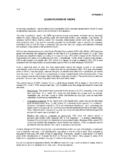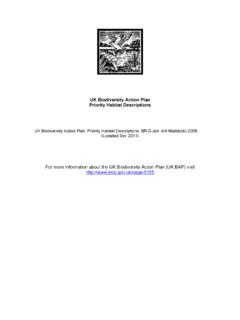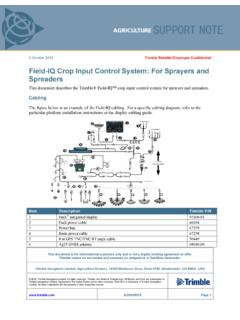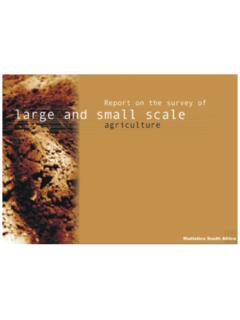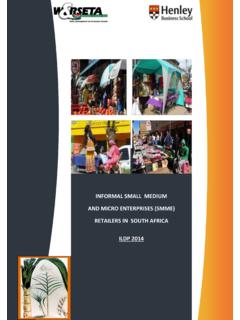Transcription of Title 30 Texas Administrative Code Section 111 Subchapter ...
1 Title 30 Texas Administrative code Section 111 Subchapter B Outdoor Burning Sec. General Prohibition No person may cause, suffer, allow, or permit any outdoor burning within the State of Texas , except as provided by this Subchapter or by orders or permits of the commission. Outdoor disposal or deposition of any material capable of igniting spontaneously, with the exception of the storage of solid fossil fuels, shall not be allowed without written permission of the executive director. The term executive director, as defined in Chapter 3 of this Title (relating to Definitions), includes authorized staff representatives.
2 Sec. Definitions Unless specifically defined in the Texas Clean Air Act (TCAA) or in the rules of the Texas Commission on Environmental Quality (commission), the terms used by the commission have the meanings commonly ascribed to them in the field of air pollution control. In addition to the terms that are defined by the TCAA, the following terms, when used in this chapter, have the following meanings, unless the context clearly indicates otherwise. (1) Extinguished--The absence of any visible flames, glowing coals, or smoke. (2) Landclearing operation--The uprooting, cutting, or clearing of vegetation in connection with conversion for the construction of buildings, rights-of-way, residential, commercial, or industrial development, or the clearing of vegetation to enhance property value, access, or production.
3 It does not include the maintenance burning of on-site property wastes such as fallen limbs, branches, or leaves, or other wastes from routine property clean-up activities, nor does it include burning following clearing for ecological restoration. (3) Neighborhood--A platted subdivision or property contiguous to and within 300 feet of a platted subdivision. (4) Practical alternative--An economically, technologically, ecologically, and logistically viable option. (5) Prescribed burn--The controlled application of fire to naturally occurring vegetative fuels under specified environmental conditions and confined to a predetermined area, following appropriate planning and precautionary measures.
4 (6) Refuse--Garbage, rubbish, paper, and other decayable and nondecayable waste, including vegetable matter and animal and fish carcasses. (7) Structure containing sensitive receptor(s)--A man-made structure utilized for human residence or business, the containment of livestock, or the housing of sensitive live vegetation. The term "manmade structure" does not include such things as range fences, roads, bridges, hunting blinds, or facilities used solely for the storage of hayor other livestock feeds. The term "sensitive live vegetation" is defined as vegetation that has potential to be damaged by smoke and heat, examples of which include, but are not limited to, nursery production, mushroom cultivation, pharmaceutical plant production, or laboratory experiments involving plants.
5 (8) Sunrise/Sunset--Official sunrise/sunset as set forth in the United States Naval Observatory tables available from National Weather Service offices. (9) Wildland--Uncultivated land other than fallow, land minimally influenced by human activity, and land maintained for biodiversity, wildlife forage production, protective plant cover, or wildlife habitat Sec. Exception for Fire Training (a) Outdoor burning shall be authorized for training fire-fighting personnel when requested in writing and when authorized either verbally or in writing by the local air pollution control agency. In the absence of such local entities, the appropriate commission regional office shall be notified.
6 The burning shall be authorized if notice of denial from the local air pollution control agency, or commission regional office is not received within 10working days after the date of postmark or the date of personal delivery of the request. (b) Facilities dedicated solely for fire-fighting training, at which training routinely will be conducted on a frequency of at least once per week, shall submit an annual written notification of intent to continue such training to the appropriate commission regional office and any local air pollution control agency. (c) Facilities dedicated solely for fire-fighting training, at which training is conducted less than weekly, shall provide an annual written notification of intent, with a telephone or electronic facsimile notice 24 hours in advance of any scheduled training session.
7 No more than one such notification is required for multiple training sessions scheduled within any one-week period, provided the initial telephone/facsimile notice includes all such sessions. Both the written and telephone notifications shall be submitted to the appropriate commission regional office and any local air pollution control agency. (d) Authorization to conduct outdoor burning under this provision may be revoked by the executive director if the authorization is used to circumvent other prohibitions of this Subchapter . Sec. Exception for Fires Used for Recreation, Ceremony, Cooking, and Warmth Outdoor burning shall be authorized for fires used solely for recreational or ceremonial purposes, or in the noncommercial preparation of food, or used exclusively for the purpose of supplying warmth during cold weather.
8 Such burning shall be subject to the requirements of (7) of this Title (relating to General Requirements for Allowable Outdoor Burning). Sec. Exception for Disposal Fires Except as provided in Local Government code , , outdoor burning is authorized for the following: (1) domestic waste burning at a property designed for and used exclusively as a private residence, housing not more than three families, when collection of domestic waste is not provided or authorized by the local governmental entity having jurisdiction, and when the waste is generated only from that property. Provision of waste collection refers to collection at the premises where the waste is generated.
9 The term "domestic waste" is defined in of this Title (relating to Definitions). Wastes normally resulting from the function of life within a residence that can be burned include such things as kitchen garbage, untreated lumber, cardboard boxes, packaging (including plastics and rubber), clothing, grass, leaves, and branch trimmings. Examples of wastes not considered domestic waste that cannot be burned, include such things as tires, non-wood construction debris, furniture, carpet, electrical wire, and appliances; (2) diseased animal carcass burning when burning is the most effective means of controlling the spread of disease; (3) veterinarians in accordance with Texas Occupations code , , Disposal of Animal Remains.
10 (4) on-site burning of trees, brush, grass, leaves, branch trimmings, or other plant growth, by the owner of the property or any other person authorized by the owner, and when the material is generated only from that property: (A) in a county that is part of a designated nonattainment area or that contains any part of a municipality that extends into a designated nonattainment area; if the plant growth was generated as a result of right-of-way maintenance, landclearing operations, and maintenance along water canals when no practical alternative to burning exists. Such burning is subject to the requirements of of this Title (relating to General Requirements for Allowable Outdoor Burning).



